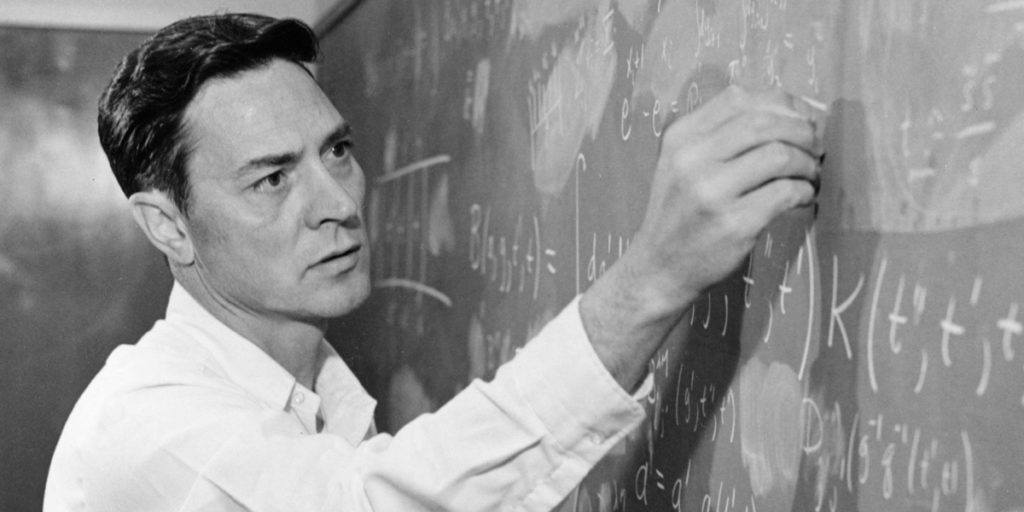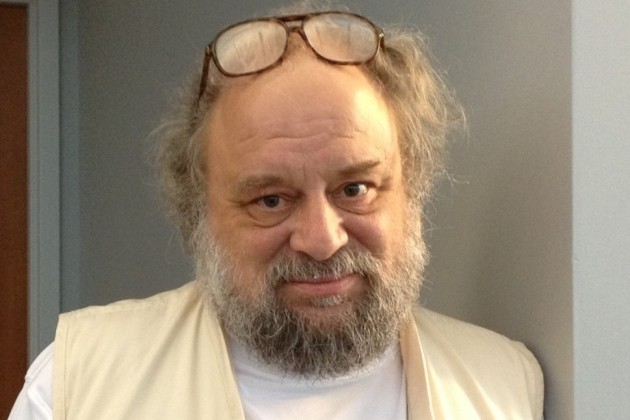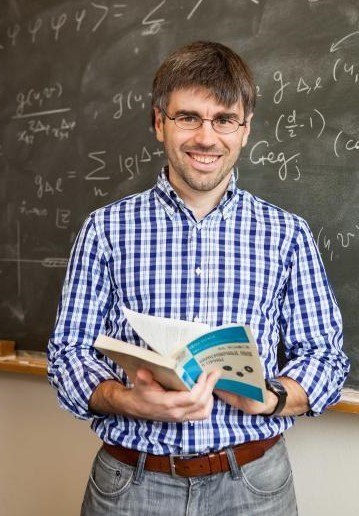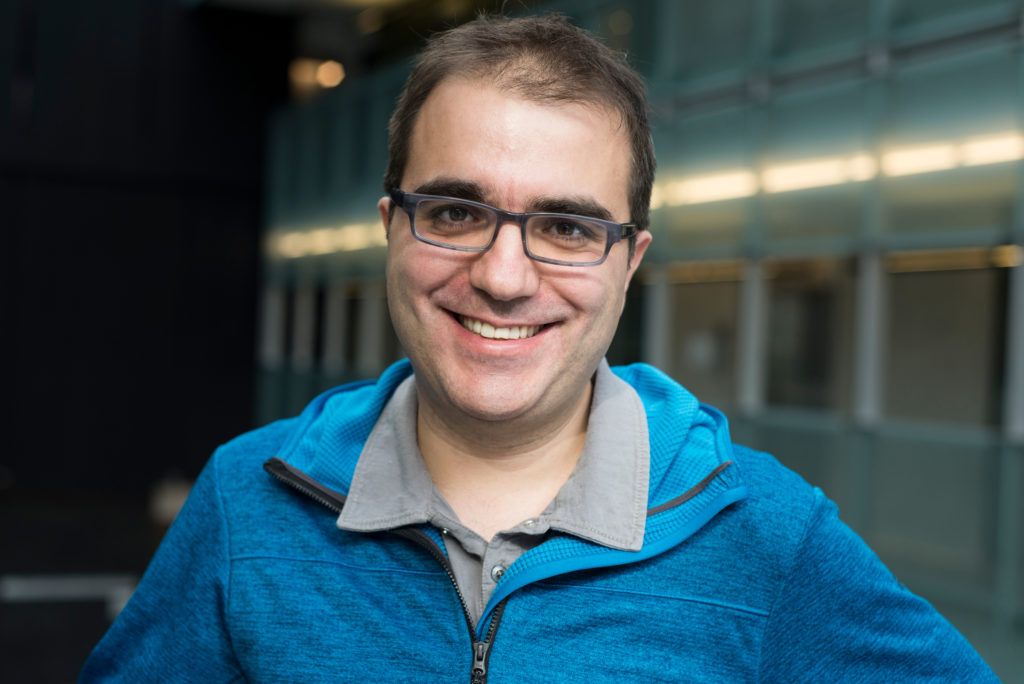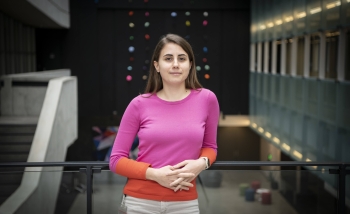It’s the opening day of the “Bootstrap 2019” conference, and Perimeter’s Pedro Vieira has an unusual warning for the 250 mathematical physicists gathered in the theatre.
“Blackboard talks only!” he says. “If you really need a slide, you should let us know so we can get it on the screen. But we like to see ideas unvarnished.”
This is how the modern bootstrapping community rolls: unvarnished and fast. The bootstrappers prefer long conferences – a month is not unknown – where the emphasis is on sharing not polished results, but promising ideas.
And so, for the three weeks of “Bootstrap 2019,” Perimeter’s atrium was transformed into the hub of an entire research field. Tables were set up, chalkboards scribbled on, ideas exchanged. New collaborations formed on the spot. There was a palpable sense of momentum.
It was hard to believe that 10 years ago, this entire research community didn’t exist.
Dawn of the bootstrap
“The bootstrap” or “bootstrapping” is an overarching term describing an approach to field theory. Roughly speaking, it’s a system for starting from general principles and generating specific knowledge. For instance, the first bootstrapping success, back in the 1960s, built up from the symmetries and principles of quantum mechanics to explain the mass of a just-discovered particle, the rho meson.
This broad-to-narrow approach is a sharp contrast to the historical approach to particles, which is to start from the smallest possible piece. That’s called atomism and it has a 2,000-year-long history, but here are the recent highlights: in the 19th century, scientists discovered atoms, and these were declared elementary particles (that is, particles with no other particles inside them). Around the turn of the 20th century, atoms were discovered to be made up of subatomic particles like electrons, protons, and neutrons, and these were declared elementary in their turn.
By the middle of the 20th century, though, protons and neutrons had acquired a bewildering batch of cousins – a zoo full of particles that came to be called hadrons. The instinct of most physicists was to drill deeper, to look for sub-subatomic particles within hadrons.
Most physicists – but not all of them. An iconoclast scientist named Geoffrey Chew proposed an entirely different way of looking at things.
Geoffrey Chew, of the University of California at Berkley, was the original bootstrapper. [/caption]
Chew wanted to discard the whole idea of elementary and non-elementary particles. Armed with the modern understanding that forces are created by the exchange of particles, he proposed that each hadron was composed of other hadrons, and the forces between them were created by exchange of hadrons. In other words, he proposed that the hadrons “pull themselves up by their own bootstraps.”
“Nature is as it is because this is the only possible nature consistent with itself,” he wrote. He believed it was possible, therefore, to deduce all the necessary facts about particles by starting with the principles of quantum mechanics, demanding self-consistency, and building up.
It was a radical, powerful idea. It gave us the rho meson mass. And then it failed.
The undiscovered country
Chew had made a flawed assumption: namely, that there was only one possible nature. That appears not to be true. For example, the masses of the quarks seem to be arbitrary, and in some other possible nature might be different.
But here, you might spot another door opening. What are all the other possible natures? If we made a map of them, what would the map look like, and where would our nature sit? In the middle? At an edge? What would that mean?
There’s another way of putting those questions. Modern particle physics is no longer described in terms of particles but in terms of fields, in which particles appear like rumples in a rug. These fields are studied via a mathematical framework called quantum field theory, or QFT.
QFT is a powerful machinery which can be – and has been – applied to nearly every problem in modern physics. The Standard Model of particle physics is a quantum field theory. So is the cosmic inflation of the early universe. Most systems in condensed matter, from water to superconductors, are described via particular quantum field theories. QFT is like a language in which physicists can say nearly anything, a skeleton key that can pick open almost any lock.
But QFT also has a problem: we know that there are many different QFTs, but we can work with only a handful of them. Others – particularly those physicists describe as “strongly coupled” – generate mathematical snarls instead of physical predictions. What’s more, we lack a general understanding of how field theory works, or even a good definition of what constitutes a field theory. This powerful piece of machinery is in some sense a black box: we don’t really know what’s going on inside it.
One basic question, analogous to “what are all the possible natures,” is “what is the space of all possible QFTs?” Surely if we knew that, we could understand this great tool a little better, and therefore use it with more skill and power. So a map of all possible QFTs is eagerly sought. Increasingly, it’s looking like the bootstrap is the right tool to make it.
The force awakens
Chew’s idea that one could describe nature starting from general principles foundered on the fact that nature turns out to be full of arbitrary particulars. But there are special situations where these particulars matter less. For instance, in thermodynamics, a gas of hydrogen and a gas of oxygen heat the same way – the difference in the mass of the particles is nearly irrelevant. A physicist would say that the theory is symmetric with respect to mass. Might the bootstrap be more useful for more symmetric theories?
In the 1970s, Russian theorist Alexander Polyakov suggested that the bootstrap could be used to gain insight into a class of field theories with conformal symmetries. In 1983, he proved it – at least in two dimensions. Working with Alexander Belavin and Alexander Zamolodchikov, Polyakov published a paper that’s such a landmark that its equations are now known by the three Alexanders’ initials: BPZ.
Alexander Zamolodchikov, of Stony Brook University, is one of Perimeter's Distinguished Visiting Research Chairs. He's been a leading bootstrap researcher for decades.[/caption]
Success with conformal field theories in two dimensions turned out to be the push that got the whole field moving. Zamolodchikov, at Perimeter for “Bootstrap 2019,” remembers moving beyond 2D conformal field theories to tackle theories with mass. “The first was a very simplified set up,” he says. “We assume that there are some particles which are only allowed to move along a line. We give them one dimension of space to move in, and one dimension of time to evolve. That’s it.
“My contribution was to apply the ideas of bootstrap to that,” Zamolodchikov continues. “It was remarkably successful. This problem wasn’t amenable to solving by traditional methods, but with the bootstrap we could derive the full S-matrix.” (The S-matrix, or scattering matrix, defines how any particle in the system might interact with every other particle.)
Despite the model’s seemingly unrealistic two-dimensional nature, this wasn’t just an on-paper proof. “It’s something which they can prepare in the laboratory,” says Zamolodchikov. “They use a long molecule to mimic the excitations of the quarks, I think. And behold: the bootstrap calculations match the experiment in a very nice way. I think there is no comparable pleasure to theorists, to see this number which you sweat out appear in an experimental result. There is nothing comparable to the feeling that we have begun to talk to nature in a more intimate way.”
Zamolodchikov had generated specific predictions starting from general principles: that’s the essence of bootstrapping. “It was so nice,” he says, “that I’m still working in similar directions. I am an old man now, but I still like this.”
Zamolodchikov and his colleagues revolutionized two-dimensional field theory. But far fewer symmetries exist in three dimensions or higher, and where there are fewer symmetries there are fewer constraints on the possible field theory. No one could make a bootstrap work to generate a three-dimensional field theory, and progress stalled.
The next generation
In 2008, in a moment of pure theoretical frustration, a young physicist named Slava Rychkov decided to pull the higher-dimensional bootstrap off the shelf and give it a close look. He and Riccardo Rattazzi were trying to build an alternative version of the Standard Model QFT that would work without the then-elusive Higgs boson.
“I knew about the bootstrap because I’m a previous student of Alexander Polyakov,” Rychkov remembers. “I thought: okay, either we’ll solve this using the bootstrap or there’s no way we can solve it.
Slava Rychov, of Institut des Hautes Études Scientifiques (IHES), helped originate the higher dimensional bootstrap research program.[/caption]
“And,” he adds, “it worked.” The question of a Higgs-less Standard Model turned out to be irrelevant – the Higgs was detected in 2012 – but in searching for it, the researchers had a powerful insight. They stopped trying to use bootstrap to pinpoint an exact field theory and started using it to sort possible theories out from impossible ones.
“Bootstrap 2019” conference organizer Pedro Vieira, who is the Clay Riddell Paul Dirac Chair in Theoretical Physics at Perimeter Institute, describes the shift in paradigm. Before, Vieira says, “people thought, if I think hard enough I’ll find a point that describes the universe. This failed – and it failed because there’s no way to use this tool to narrow things down to a single point. There are many possibilities, many theories that might describe a possible universe; we just turn out to live in one of them. But it’s not like there is anything wrong with the other options – they just aren’t realized in nature.”
The range of possible theories, then, is not a series of points but a finite space; not a series of isolated stars but a patch of sky with stars in it. The 3D bootstrap makes progress not by pinpointing more stars but by mapping the sky.
Mathematically, this shift in paradigm is a shift from equalities (the assertion that nature equals such and such) to inequalities (the statement that nature must be greater than this, smaller than that). The inequalities act as bounds on the possible theories: they narrow the patch of sky. Every time researchers discover a symmetry in a theory, they can introduce another inequality and in this way gradually get the theory cornered. Often the result is a patch of sky so small that it seems to contain only one star: one effective theory.
It also happened that computer science had already developed a technique precisely to deal with inequality-driven problems. Linear programming gave modern bootstrappers computational power beyond the dreams of their 20th-century forebears.
Rychkov, together with David Poland and David Simmons-Duffin, began applying their inequality-driven mathematics to other field theory problems and started making unexpectedly rapid progress – so rapid that many thought it was a fluke or an error. But as results continued to flood in, Rychkov says, “suddenly it was becoming clear that the potential of the bootstrap research program was not just a mirage.”
Vieira, though not yet working on the bootstrap himself, was so intrigued that he thought a conference was in order. “I thought, this is really powerful, this new idea of the bootstrap that Rychkov and Rattazzi and others were starting. At the time it was being applied to this curious example of a strongly coupled Higgs model. But we thought it could be much more general. It could be about the study of the whole space of theories.”
Back to the bootstrap
Vieira, João Penedones (then a Perimeter postdoctoral researcher), and Leonardo Rastelli of Stony Brook organized first “Back to The Bootstrap” conference at Perimeter in 2011. It was a small conference: three days long with about 20 participants.
Pedro Vieira, the Clay Riddell Paul Dirac Chair in Theoretical Physics at Perimeter, helped found the conference series that bootstrapped the bootstrap community.[/caption]
“I think it’s fair to say this community was created here in that first meeting,” says Vieira. “In my view, it’s one of the most successful meetings ever. It was very informal. We didn’t keep a schedule – we said, this morning we’ll talk about X, and there was a discussion leader and real discussion. Many projects started there.”
The bootstrappers have held a conference every year since. Greeting the 250 participants at the 2019 iteration, Vieira noted: “At a certain point it became silly to say ‘Back to the Bootstrap.’ The bootstrap is back.”
The bootstrap is now, in fact, several different bootstraps, overlapping in places and diverging in others. The community now involves hundreds of researchers and dozens of important papers a year.
What unites them is that they all leverage inequalities to explore the space of field theory. In condensed matter, bootstrappers are making precise predictions about the field theories that describe particular systems. In particle physics, bootstrap tests are used to narrow down the nature of possible theories that may lie beyond the Standard Model. There are even researchers bootstrapping their way toward quantum gravity.
“There are people who are focusing more on the side of trying to extract predictions. This usually goes under the name of numerical conformal bootstrap,” explains Rychkov. Bootstrapping this way is a bit like finding the highest point of an island not by mapping each square inch but by gradually raising the sea level. It may not be quite as precise, but it’s a lot more efficient, mathematically speaking. If the bootstrappers can find enough inequalities to raise the sea level high enough, the above-water peak can be quite small – small enough to make experimental predictions.
Rychkov likes this aspect of the work. “I always find it extremely motivating when I can get some result and I can compare it to experiment,” he says. “It’s a great intermediate step. You then go back and learn some deep things about conformal field theories, and then you put those things to work to improve your comparison to experiment, and then this motivates you to go back and to learn even more things.”
It is, he says, a virtuous cycle: “There is mathematical beauty and there is concrete relevance, and I think the bootstrap is a good balance.”
The final frontier
Vieira is not as interested in raising the water level as he is in mapping the entire shoreline. While many branches of the bootstrap program revolve around conformal field theories, Vieira is interested in field theories that have something that conformal field theories lack: particles with mass. This branch of the research program is called the S-matrix bootstrap.
Because it lacks the extra symmetries that go with conformal theories, the S-matrix bootstrap can be challenging, so Vieira starts with a simplification. “We always go to two dimensions, develop our weapons there,” he says.
The space of all allowed two-dimensional field theories has something that the higher-dimensional space lacks: fixed stars to act as signposts. That’s because Zamolodchikov’s 2D bootstrap program, described above, generated a huge number of known examples of two-dimensional theories.
“When we carve out a map of all allowed 2D theories, we have all these points that have to be inside the space of allowed theories, because they are explicit examples,” says Vieira. “If our region excludes a theory that Zamolodchikov found, then our theory is wrong. Zamolodchikov – he knows everything about two-dimensional field theory. He’s like an oracle.”
What’s more, the placement of the Zamolodchikov signposts turns out to be interesting. “For example,” says Vieira, “recently we were exploring scattering theories in two dimensions, and we found this beautiful three-dimensional shape – the inside representing allowed theories, and the outside representing excluded theories. This shape has vertices and edges and cusps. And exactly at the cusps, at the most interesting points of this theory space, lie Zamolodchikov’s theories.”
It’s a pattern that’s holding up as Vieira makes strides toward the long-sought goal of a map of all three-dimensional theories. “When we go to higher dimensions, the theories that we seem to find at the most interesting point are the theories that describe the real world,” says Vieira. “The results of the experiments are close to – or at – the boundary of allowed theories, not deep inside the allowed region. And, typically, we are finding that the most interesting theories are in the most interesting places.”
It can work the other way around, too: as Vieira finds more interesting places on his map, previously unknown physical theories are often discovered there. It’s suggestive, but suggestive of what?
“I don’t know,” says Vieira. “When things are at the border – well, in Canada, most of our cities are close to the border with the US, because people wanted to get warmer. So they go down, down, down, down, until the border means they cannot go down any more.
“To me, it looks like physical theories are trying to do the same thing. They want to move in some direction. So they move, move, move, move, until they cannot move more because they would be violating some principle of unitarity or causality or something.”
What would they be moving toward? We simply don’t know. Maybe there is a symmetry that we have yet to discover. Or perhaps some quantity has to be minimized or maximized, and that pushes the theory to the edge. Finding out might lead to more insight into field theory generally. It could be the key to the map.
Zamolodchikov, oracularly, has a different explanation. “Why do we live at the boundary of the impossible? Because it’s more interesting this way,” he says. “Whoever creates the dust probably had in mind not to be boring.”
Further exploration
About PI
Perimeter Institute is the world’s largest research hub devoted to theoretical physics. The independent Institute was founded in 1999 to foster breakthroughs in the fundamental understanding of our universe, from the smallest particles to the entire cosmos. Research at Perimeter is motivated by the understanding that fundamental science advances human knowledge and catalyzes innovation, and that today’s theoretical physics is tomorrow’s technology. Located in the Region of Waterloo, the not-for-profit Institute is a unique public-private endeavour, including the Governments of Ontario and Canada, that enables cutting-edge research, trains the next generation of scientific pioneers, and shares the power of physics through award-winning educational outreach and public engagement.
You might be interested in

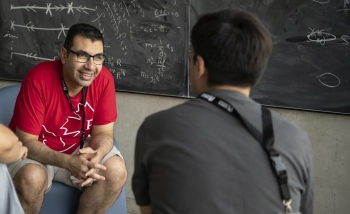
Perimeter Hosts Strings 2023: Spotlighting new directions and uniting a community
September 22, 2023
